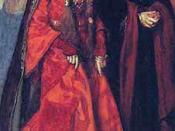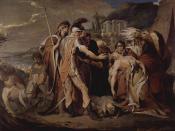In Act Two of King Lear we see Lear's emotional deterioration. In a very short time Lear progresses from denial to rage to isolation. The audience can see this in Lear's language; when he is in denial he speaks formally to Regan hoping what he has heard is wrong. This leads to Lear begging her for help, which is the transitional stage where the truth begins to sink in with him. His language changes again when he finally understands that Regan will not see to his needs and has sided with Goneril. His language becomes much more informal, cursing both of his daughters and expressing his rage. Language does not affect the audience's understanding of Lear's isolation because this stage begins when Lear leaves and then we do not hear from him again. Lear's entourage is a symbol of his pride and honour, Goneril and Regan's attempt to deny him of his entourage is what causes him to fall into a fit of rage and eventually isolation.
Their ganging up on him about his entourage (threatening his pride and honour) induces a transition from denial to rage. The storm at the end of the act is a symbol of Lear's emotional upheaval. It also serves as a transition from rage to isolation. If one watches (or reads) the play carefully it is evident where each of the three emotional states begin and end by Lear's character development, and the use of symbols and language.
For the most part of the act Lear is in denial. It begins with his disbelief that Regan would leave when she knew he was coming and not return his messenger. Lear finds Kent in the stocks and will not believe his explanation of why he is in there, "It is both he and she.


